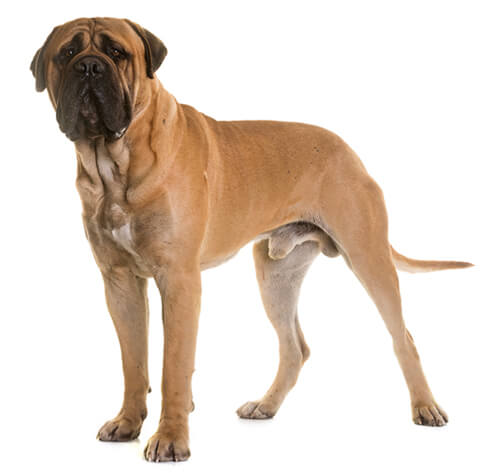
The Bullmastiff’s history began in 19th-century England where he was developed to keep large estates and game preserves free of poachers. Fearless and confident yet sweet-natured and docile, the breed makes a great family companion. Natural guardians, Bullmastiffs do not bark much and require minimal exercise and grooming. For a large dog, the Bullmastiff does well in an apartment as well as a house.
DID YOU KNOW? A Bullmastiff called “Mac” starred in a Honda Odyssey Super Bowl commercial in 1999.
The need-to-know
- Dog suitable for experienced owners
- Extra training required
- Enjoys active walks
- Enjoys walking an hour a day
- Large dog
- Minimum drool
- Requires grooming once a week
- Non hypoallergenic breed
- Quiet dog
- Guard dog. Barks, alerts and it's physically protective
- May require training to live with other pets
- May require training to live with kids
Personality

These dogs are very protective of their family and other household pets, and so have to be socialised from an early age. The Bullmastiff will only accept strangers if they are introduced to them by someone they trust. Other visitors/strangers will be quickly halted in their tracks. It is not really a breed for the novice owner, due to its strength, stubbornness and over-protective nature.
History and Origins

The Bullmastiff dog breed was originally called the 'Gamekeeper's Night Dog' as they were used to catch poachers. The base stock of the Bullmastiff was 60% English Mastiff and 40% Bulldog. They were created in the late 1800s. When the need for gamekeepers and the Bullmastiff declined they were used in sport. Someone would run off into the undergrowth and, after a short time, a muzzled Bullmastiff would be released to see if the person could be found. They were not trained to maul or kill, but to overpower their target.
Nutrition and Feeding

Large breed dogs, as well as having large appetites, benefit from a different balance of nutrients including minerals and vitamins compared to smaller-breed dogs. The Bullmastiff is prone to bloating and stomach problems; smaller, more frequent meals can help minimise this risk.
Exercise

This dog should be carefully controlled until at least 12 months old. Too much exercise too young can lead to bone and joint problems in later life. They do enjoy exercise and games with the family, and a couple of hours of exercise daily will keep an adult Bullmastiff content.
Other Information

Health and common issues
As with many breeds, Bullmastiffs can suffer from various hereditary eye disorders, and hip and elbow dysplasia (joint conditions that can be painful and lead to mobility problems). Eye testing and hip scoring of dogs prior to breeding is therefore important. They are also prone to a particular bladder condition and ligament problems in the knee (cruciate disease).
Best family dog breeds
While many dogs are traditionally thought of as being good with children , all dogs and children need to be taught to get on with and respect each other, and be safe together. Even so, dogs and young children should never be left alone together and adults should supervise all interactions between them.